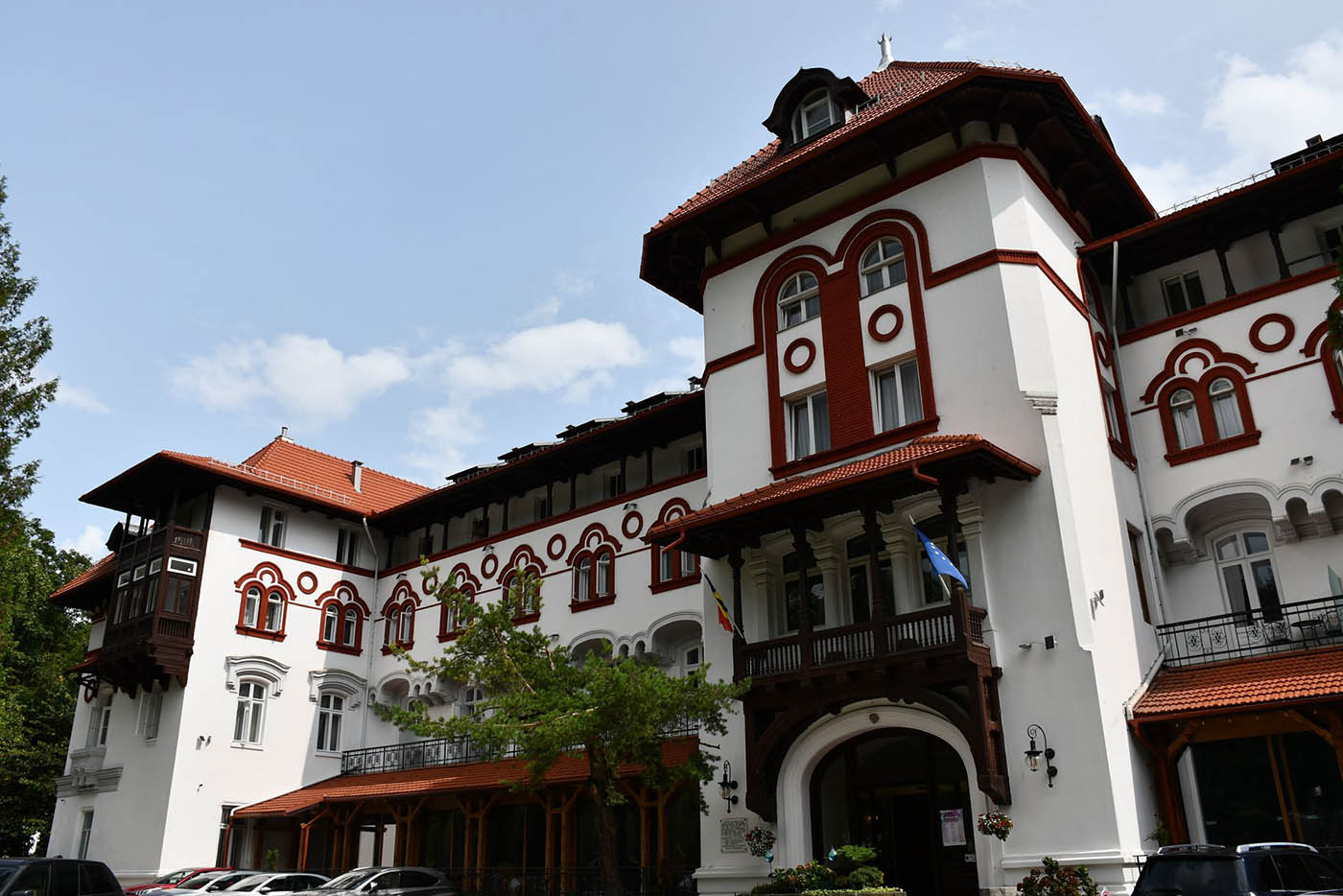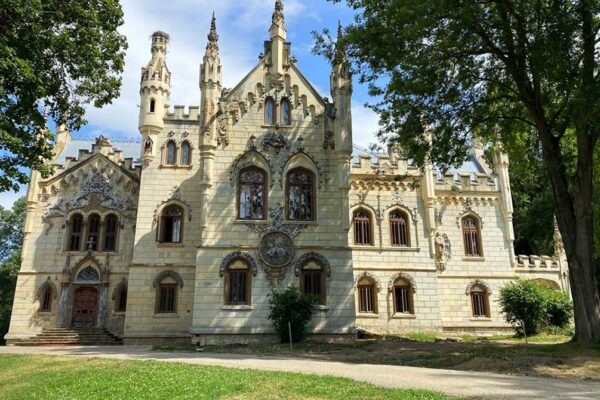
Urzeln tradition in the Harbach Valley | Agnetheln | Transylvania
31 January 2024
Thirteen lesser-known museums in Bucharest
26 February 2024Sinaia, the pearl of the Carpathians
Known to many today more as a winter holiday resort, ski resort or luxury holiday destination, the city of Sinaia, just 120 km from Bucharest, is a true open-air museum with almost 100 existing monuments. As the Romanian city with the most historical monuments in terms of population density, its architectural gems live up to its nickname “Pearl of the Carpathians”. If you take a stroll through Sinaia, you will discover an architectural monument in almost every second house.
Three railway stations, two of which are royal
As soon as you get off the train in Sinaia after a beautiful train ride along the Prahova Valley, you come across the city’s first monument: the two royal railway stations, which were reserved for the royal family or for visits by high dignitaries, and the general railway station – all three just a few metres apart.
The general railway station was built at the end of the 1870s and was soon rebuilt in a neo-Romanian style due to the large number of tourists. In 1886, the first royal railway station was built next to it, which functioned as such until 1940, then served various other purposes and today houses an interactive railway museum.
King Charles II of Romania commissioned the renowned architect Duiliu Marcu to build a new royal railway station, which was completed in 1940. The royal railway station, which is still functional today, is built in a modern, cubist, simple style, completely clad in local stone and is used to receive visits from the President of the Republic.
Instead of walking along the winding station road, we take a shortcut via the Caraiman path, if the luggage is light, and climb the mysterious stone staircase under the cool shade of the trees, which leads directly to the city centre. Once in the heart of Sinaia, you might wonder where the beautiful, exotic-sounding place name comes from. The answer is just around the corner on the right, a few hundred metres away, in the Sinaia Monastery.
Foundation of the town
Inhabited since the Bronze Age, a modern human settlement was first mentioned in a document in 1581 by the small Romanian Orthodox monastery of St Nicholas on the Molometz/Molomeț peak in the area then known as Prahova Pasture. Boyar Mihail Cantacuzino later sought refuge with the local hermits when he was pursued by his father’s murderers and promised his saviours that he would build a large monastery if he got away.
In 1695, he kept his promise after being crowned Sword Bearer of Wallachia and christened it “Sinaia” – after Mount Sinai, which he had climbed on his pilgrimage to the Holy Land.
Today, the monastery grounds include the old premises, the old monastery church, the tomb of Prime Minister I. Gh. Duca, the old monks’ cells, the first monastery museum in Romania, opened in 1895, and the new Church of the Holy Trinity, built in 1900. Over time, more people settled around this monastery and Sinaia served as a refuge, especially for the people of Bucharest, during the Turkish attacks in the 19th century.
The settlement only became a town in the second half of the 19th century, when the first road from Brasov and the first railway for pleasure trips from Bucharest to Sinaia were built, the noble families Cantacuzino and Ghica established civil hospitals with free treatment here and Prince Charles I of Hohenzollern-Sigmaringen, newly crowned ruler of the United Romanian Principalities, decided to build a summer palace in the area.
The royal estate of Pelesch/Peleș, located in the river valley of the same name, was financed by the future King Charles I with money from his private fortune after he fell in love with the enchanting landscape in his first year of rule as prince in 1866 and had the castles of Pelesch, Pelișor and the hunting lodge of Foișor built on it. The three castles and the neighbouring buildings of the courtiers deserve a separate article dedicated to them.
Eating in listed buildings
Full of history and culture, but a little tired from an impressive tour of the castles, you can relax with a refreshing frappé and a piece of that popular, particularly tasty sweet from the neighbouring café “Regal” – or “Bei den Kanonen”, as it is popularly known. If you get hungry, you can also enjoy a pizza between the authentic Turkish cannons or savour a good meal in the nearby “Villa Economat” restaurant or in the “Carol” gastro-beer house opposite.
An unexpected culinary experience is offered by the house of royal advisor Constantin Bușilă, popularly known as the “Casa cu farfurii” (House with Plates) restaurant-hotel opposite the Sinaia Monastery. The stone house, designed in neo-Romanian style by architect Duiliu Marcu, has a rustic wooden terrace decorated with ceramic plates. It was sold to Ajax Manthopoulos, the nephew of Greek actress Irene Papas, after the fall of communism in 1989 and therefore offers appetising Greek dishes in generous portions.
For those who prefer spicier, aromatic food, the Ramayana restaurant serves Indian fusion food on the ground floor of the neo-Romanian-style Rina Cerbul Hotel (19 Karl I. Blvd., city centre), whose roof is supported by rows of white columns.
The range of restaurants, guesthouses and hotels in Sinaia is quite rich and prices range from affordable to very high, as it is the holiday and health resort of the former elite of the Kingdom of Romania and today’s more affluent people.
Hotels are also part of the cultural heritage
Initially managed as a health resort by the noble Ghica and Cantacuzino families, board members of the Civil Hospitals Foundation, large landowners were invited to Sinaia to buy land and have so-called “health houses” built.
The first to be completed in 1975 were the villas of General Ion Florescu, then Minister of War, and Prince Dimitrie Ghica in the city centre. The Florescu estate includes the Știrbei Florescu Palace – a romantic miniature stone palace with its main terrace and monumental access stairs facing its own park and the city, which today houses the city museum – as well as a staff residence and a Roman Catholic chapel designed by André Lecompte du Noüy in the neoclassical style and painted by the famous artist Gheorghe Tattarescu.
The present-day Casino Sinaia was built on the site of the former villa of Prince Ghica and the neighbouring Hotel Sinaia – the first in the village – which burnt down in a fire, and the estate’s garden was opened to the public as a park.
To the right of the elegant, Art Nouveau-style casino still stands the “Palace” hotel, a large building of classical elegance, and the neighbouring rustic “Regal” hotel, covered with finely carved wooden lace. Opposite, beyond the centrally located fountain, rises the neo-Romanian “Caraiman” hotel, painted white with brick-coloured accents. There are also hotels designed in the German Renaissance style in Sinaia, the most famous of which is the hotel-restaurant “Furnica” (50 Furnica Street). Built at the same time as the neighbouring castles as a half-timbered building with a green roof, it is under the administration of the Romanian Domestic Intelligence Service (SRI) due to a decree approved by Parliament in 2018 and has been closed since then.
High density of monuments everywhere
The Nicolae Iorga Memorial House (No. 1 Gh. Doja Street), the historian’s last residence, and the George Enescu Memorial House, at No. 2 Yehudi Menuhin Street, both built in the neo-Romanian style, are somewhat more hidden and further away from the city centre.
At No. 7 Theodor Aman Street in the Furnica neighbourhood, a Swiss chalet seems to rise up: The steep roof and wooden beams of Villa Sașa Romano are reminiscent of this. From here, walk along Mihail Kogălniceanu Street to no. 68, where the villa “Anastasie Simu” or “Retezat” is located. It was designed between 1903 and 1911 in the German Renaissance style by Czech architect Karel Liman and belonged to the academic and art collector of the same name.
Also on Mihail Kogălniceanu Street is the former villa of engineer Vasile Ionescu, completely clad in stone and with a wrought-iron balcony in Art Nouveau style. Opposite is the “Carmen Sylva” cultural centre, which was built in 2008 on the site of the first primary school in Sinaia. Due to its location on a hilltop, the centre building can be seen directly from Bd. Carol I or from Aosta Street, where a few steps lead up to it.
Another imposing half-timbered villa, this time designed by the Swiss architect Henri Süsskind, bears the name of its former owner, the National Liberal Prime Minister Take Ionescu, and is located on the street of the same name at No. 2. The influence of the German Renaissance is clearly visible in the buildings that make up the villa, especially in the windowed galleries, balconies, bay windows and beams, all of which are made of dark wood.
If you descend to the centre of the city, on the main street of Sinaia, on Blvd. Charles I, you will discover several buildings with a certain historical and architectural value standing side by side: at number 35, the “Villa Emil Costinescu” from 1892, a mountain-style building, at number 43, the George Ionescu House from 1881. Further on, at number 47, there is the neo-Romanian building that has housed the Sinaia City Hall since 1905. Next door, at no. 49, is the imposing Slătineanu House or Villa Salamandra, named after one of its owners and the shape of the medallions that adorn it.
On the opposite side of Boulevard Carol I, three more listed buildings line up: at no. 40, the architect George Madrea designed his own house, named after him, in 1890, where tourists are now accommodated in the Duca Inn. Next, at no. 42, you can admire the Albert Litman House or “Villa Margot”, a fin de siècle building from 1890. Finally, at no. 40 is the Radu Mavrodineanu House, which was built around the same time.
If you turn right immediately afterwards onto Alexandru Vlahuță Street, more listed buildings await their admirers: Harmonious synthesis of architectural styles or the representation of individual architectural styles, the craftsmanship of the stone, its interplay with the cast-iron or forged iron elements of the balconies, the wooden spire with skilfully perforated wooden beams on the roof of the terraces, the balconies or the main staircases are all elements that make up the enjoyment of architecture enthusiasts during a “city break” in Sinaia.
ADZ | Allgemeine Deutsche Zeitung für Rumänien
Text & Images: Cristiana Scărlătescu




















